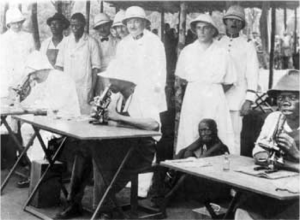
Workshop: 15-16 April 2021, University of Basel
Deadlines for propositions: 15 October 2020
Over the last thirty years, photographs have become important sources of information for scholars seeking to reconstruct and examine the African past – whether related to material objects, social processes and practices, or attitudes and sensibilities. In employing visual evidence, historians and anthropologists recognise and reflect critically on photography as a complex and historically contingent practice, and images as polyvalent and often ambiguous artefacts.
This workshop seeks to apply theoretical and methodological insights produced by visual historians to the writing of histories of medicine, health and healing in colonial and postcolonial Africa. Over the course of the ca. 150 years since the introduction of photographic technology in Africa, it has been employed in a myriad of manners and settings related to health. Historians are confronted with depictions of everything from clinical work, public health education campaigns and pharmaceutical interventions, to buildings, equipment, specimens and anatomy.
During this two-day workshop, hosted by the Department of History at the University of Basel, scholars working at the intersection of visual, medical and African history will explore the opportunities and challenges of using photographs to write histories of health and healing in colonial and postcolonial Africa. We seek to create a diverse and supportive cross-generational environment in which to workshop works in progress, with the guidance of experts in these fields. Themes we will explore in relation to our sources and research include:
Ambivalence: Photographs are ‘realistic’ – that is, apparently objective, accurate and even scientific. This ‘folklore of photographic truth’ (Sekula 1978:862) is particularly powerful in the medical field, where images are invoked as visual evidence of disease, causation and cure. But this apparent visual certainty is at best unstable. Photographs can only suggest relations between the visible and invisible, in this way constituting rather than witnessing to conditions of health or illness. Moreover, they may hide as much as they reveal, selectively omitting certain things from the frame. How do we navigate this ambivalence?
Power relations: Visual historians highlight the unequal power relations inherent in the production, circulation and consumption of photographs. Health-related photography, whether from colonial, humanitarian or global health contexts, is particularly problematic in this regard, often reflecting the objectification of less powerful and racially different subjects for purposes of control and classification. How can we utilise the scientist’s scrutiny, doctor’s observation or epidemiologist’s surveillance without normalising this gaze? Can photographs produced in such conditions reveal subaltern agency and allow us to do medical history from below? And how do we move beyond a paradigm of domination and resistance and read images for what they reveal about subtle changes in social attitudes and relationships, ideas or bodies of knowledge?
Framing: Photographic practice, cultural epistemologies and disciplinary frames all shape images. What is the role of the material arrangement, financing, posture, and positioning in the production, reception and circulation of photographs, and how does this structure our perception of the image? Western colonial epistemologies typically coded Africans as primitive, exotic and ignorant, and Westerners as modern and scientific. Health-related photography – whether clinical, epidemiological or humanitarian – added associations of disease and infection to understandings of “natives” and their environment, and dis seminated tropes of heroic and resourceful white doctors and humanitarians helping passive black victims. How do we read photographs for and beyond these epistemologies? Disciplinary frames often reinforce the biomedicalization of health and healing through a focus on disease and biomedical interventions which reduce patients and communities to their afflictions. How do we critically approach this?
Intertextuality and genre: The labelling or classification of images – by their producers or institutions, but also subsequently by archivists – affect our reading and approach, or even ability to locate them. How do we critically interrogate and dismantle these genres and categories? How do we utilise, without becoming constrained by, the information surrounding a photograph – captions, explanatory notes, correlative texts or archival descriptions? And, how do we approach images which have become ‘orphaned’ from such associations, dislocated in time and space?
Ethical considerations: The visual historian must bear in mind ‘the perception that photographs of people somehow contain or capture their subjects, and that they therefore carry a burden of care’ (Biernoff 2011:330). How, where and by whom may images of patients, injured or ill bodies be seen? How do we utilise such visual material for research purposes and reconcile such ethical considerations with pressures to present our research visually?
We invite graduate students, early career and established scholars who are employing photographs to write histories related to medicine, health and healing in Africa to present their work in progress and participate in discussion around these themes. Please submit an abstract (ca. 500 words) and biography (ca. 100 words) to Danelle van Zyl-Hermann (danelle.vanzyl-hermann@unibas.ch) by 15 October 2020.
Participants will be asked to precirculate material in preparation for the discussion – details will be communicated. The organisers will endeavour to secure financial support for participants, particularly those travelling from Africa. Current planning is for the workshop to take place in Basel with all participants in physical attendance. This will be monitored and any adjustments communicated to participants in accordance with the public health situation.
Organised by :
